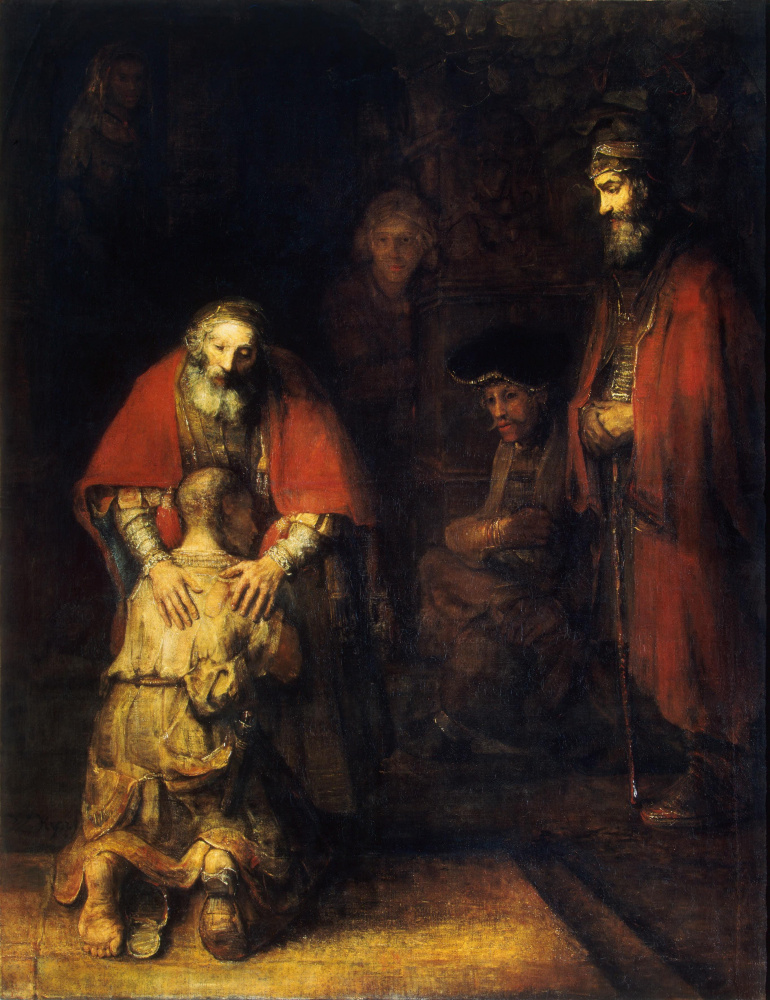log in
Enter site
Login to use Arthive functionality to the maximum
The return of the prodigal son
Rembrandt Harmenszoon van Rijn • Peinture, 1668, 262×205 cm
Descriptif de la toile «The return of the prodigal son»
In the second half of the 1650s Rembrandt's years suffered a string of failures. Multiple debts ruined his paintings did not bring almost no income. Declaring bankruptcy, he sold all of the property and moved to Amsterdam. He lost his collection, consisting of beautiful art, without a faithful and loving wife Hendrickje, who died, being excommunicated from the Church for fornication with Rembrandt, became ill with tuberculosis his son Titus, and daughter-in-law died of despair. Patient semigone blind, abandoned by all, unable to hold the brush and therefore binds it with twine, the artist paints his final masterpiece.
Rembrandt "The return of the prodigal son" was created shortly before the death of the painter in 1669. It depicts the final scenes from the gospel parable: the younger son departed from his father's house once, and returned, full of remorse. Falling on his knees in front of the old father, he buried his face in his knees, hoping for forgiveness. Head the burden of their heads shaved, clothes more like rags beggar, shoes trampled the whole appearance of the stranger said that he happened to see a lot and go through various tests.
Father, carefully written out on the Rembrandt painting "the prodigal son", bowed his head over the miserable, like he was listening to his whisper. He leaned over her son, resting her hands on his shoulders; the old man's face expresses a feeling of sad joy and forgiveness. These two figures — the father and the son is like to become one, merged in a hug. Bright light falls upon them, and the figure of the eldest son, standing at a distance and with a slight sadness looking at this scene. For Rembrandt, these three characters had their importance: "the Return of the prodigal son," he tells the story of his own life, full of passion, searching, suffering and hope.
He repeatedly addressed this parable. In early sketches the artist had beaten the story, revealing the soul of the son, showing the amazement of the old father, due to the unexpected meeting. In the latest version of "Return of the prodigal son" Rembrandt's emphasis on the father figure, radiating love and forgiveness. Critics believe that the three main characters of the painting represent the artist in different years of his life.
Depicted on the canvas, minor characters seemed to speak from the shadows. Next to big brother, we see a richly dressed man in a beret who sits, crossing her legs and watching with interest what is happening — presumably it's another brother. In the background one can see the barely distinguishable figures, which may be the servants of the Lord.
In 1766 "the Return of the prodigal son" by Rembrandt acquired the Duke de Really Prince Golitsyn, carrying out the instructions of Catherine. The painting was placed in a Hermitage, where he remains to this day.
Rembrandt "The return of the prodigal son" was created shortly before the death of the painter in 1669. It depicts the final scenes from the gospel parable: the younger son departed from his father's house once, and returned, full of remorse. Falling on his knees in front of the old father, he buried his face in his knees, hoping for forgiveness. Head the burden of their heads shaved, clothes more like rags beggar, shoes trampled the whole appearance of the stranger said that he happened to see a lot and go through various tests.
Father, carefully written out on the Rembrandt painting "the prodigal son", bowed his head over the miserable, like he was listening to his whisper. He leaned over her son, resting her hands on his shoulders; the old man's face expresses a feeling of sad joy and forgiveness. These two figures — the father and the son is like to become one, merged in a hug. Bright light falls upon them, and the figure of the eldest son, standing at a distance and with a slight sadness looking at this scene. For Rembrandt, these three characters had their importance: "the Return of the prodigal son," he tells the story of his own life, full of passion, searching, suffering and hope.
He repeatedly addressed this parable. In early sketches the artist had beaten the story, revealing the soul of the son, showing the amazement of the old father, due to the unexpected meeting. In the latest version of "Return of the prodigal son" Rembrandt's emphasis on the father figure, radiating love and forgiveness. Critics believe that the three main characters of the painting represent the artist in different years of his life.
Depicted on the canvas, minor characters seemed to speak from the shadows. Next to big brother, we see a richly dressed man in a beret who sits, crossing her legs and watching with interest what is happening — presumably it's another brother. In the background one can see the barely distinguishable figures, which may be the servants of the Lord.
In 1766 "the Return of the prodigal son" by Rembrandt acquired the Duke de Really Prince Golitsyn, carrying out the instructions of Catherine. The painting was placed in a Hermitage, where he remains to this day.


